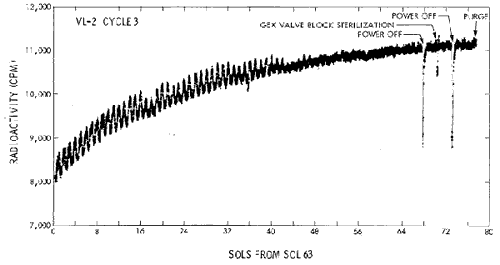
But that's not all. Harold Klein (lead scientist
for the Viking biology experiments) and
Gilbert Levin (another member of the team) have
argued for a long time that the experiments
in fact did detect life on Mars.
After all, remember the experimental results.
Here are the results of the reaction of
Martian soil in the labeled release experiment:

In 1997, this plot grabbed the attention of a biologist
at USC who studies circadian rhythms: the period of
oscillations in the plot is equal to 24.66 hours -- exactly
one Martian day.
Could this be a signature of life? Perhaps. Some wonder
whether it is a temperature effect, although the
experiment was designed to minimize temperature effects.
Additionally, Miller says that this signal persisted
for nine weeks after the Viking lander, and that any
nonbiogenic soil activity would have only lasted
a few days.
So the debate continues, even after 25 years. Levin
has suggested putting a chirality experiment on
a future lander to address the question using
a different technique.
The present landers have no tools to investigate
these uncertain results.
It may be a while before we truly know the
answer!